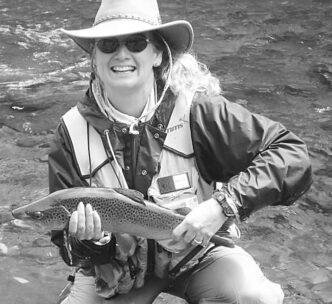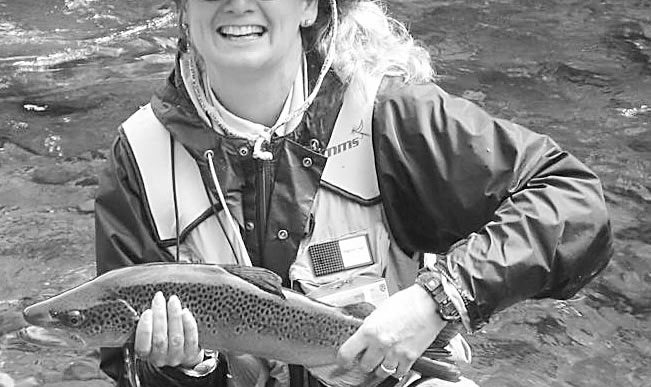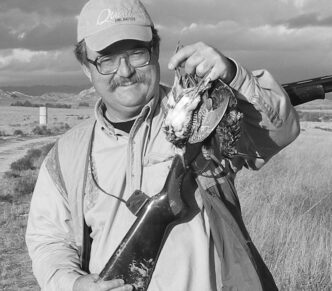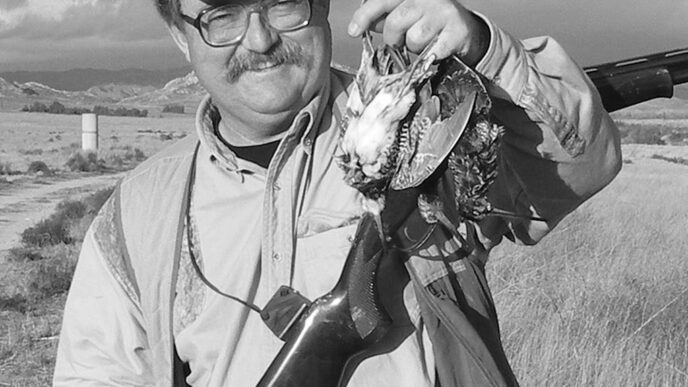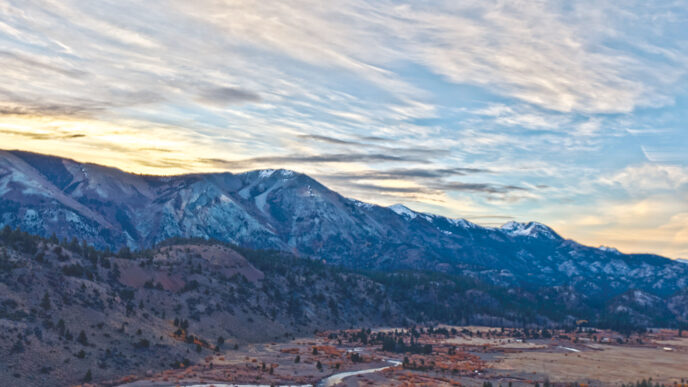Every fly fisher has a hundred surprising experiences that provoke “How about that?” reactions. Anomalies, accidents, or one-offs: we remember a few, but most fade from memory after a decent dinner and a full night’s sleep. The remainder may return — pop through the mind’s meniscus if a similar prompt repeats: Hasn’t this happened before? A third, fifth, or thirty-second repetition may make you wonder a little or lots. What happens then . . .
Let’s start with an example common to many anglers, early on or eventually, then push it to make a point:
Late on a slow day you let a Hare’s Ear hang in current at the end of the drift. It’s an accident, more or less. You’re searching a box for a magic fly when your rod jerks halfway out of your armpit.
You missed that hit, so you try another swing-and-hang. You’re slammed again: fish on.
It’s a “How about that?” On the way home you file the phenomenon under “Things to think about someday.”
Someday comes. The prompt repeats, your armpit injury taps memory. But now you think you’re onto something, so work the tactic downstream. Success sparks thoughts, so it occurs to you that this fly you usually tumble through deep runs to mimic crawling mayfly or stonefly nymphs might also imitate an emerging caddis when it swings into a riffle, then rises on a tight line.
Plausible. Interesting hypothesis — and haven’t you read about this somewhere? Certainly a notion worth exploring.
Maybe you do. Or maybe you stop at a diner where meatloaf tastes like Mom’s, the slabs as big as a brick, but heavier, so the next day you sleep until noon. In that case, caddiswise, you might be back to “Things to think about someday.”
Which — what do you know — comes along a week or year later.
Now you’re impressed. And you see caddisflies in the air. Suddenly, a fair notion is edging toward hypothesis. And if you really think you’re right . . .
What would happen, you wonder, if you added a little more caddis-emerger specific materials to your Hare’s Ear’s dubbing. “Trilobal fibers,” you whisper, inspired by Gary LaFontaine. A tuft of tan you find floating on your desk, scrap o’ white leftover from a parachute post, add these to the clippings from some bunny’s face, twist this motley blend into a dubbing loop, rib with copper and . . . — voila! Half a dozen hours of field research convinces you your “Wild Hair” outscores the tried-and-true version by two to one.
What do you know?
No, I mean what do you actually know? Not much, if you’re measuring by standards intended to identify neutrinos entering from another dimension. Enough, if you’re developing a conviction about a tactic and fly that will put fish on your line for the rest of your years, which is what will most likely happen. And the truth is that it is reasonable to rely on anecdotal and statistically insignificant evidence when there is, cosmically speaking, so little at stake. Our own experience and observations, supported by those of people we trust, is as much as we have to work with when pondering most decisions. You had a wild-hair notion that worked out for you, never mind that you’re missing some absolute answer you’ll never learn. Beyond that, what does it matter if you’re wrong? Who’ll die?
If somebody might — when there’s more at stake, including implications dire — you’d take a lot more care. Goes without saying: it’s a long road from notion to hypothesis here, and you want a mountain of evidence, not a hump or mound, and even if you think you’ve reached some summit, you won’t yodel until you’re sure.
So let’s step up to that level, if we can, still contemplating fly fishing. For fun and to further our education.
This time, imagine you have a notion about fly fishers as a group, derived from experience, but almost all anecdotal. It’s a feel-good hypothesis — a conviction almost — yet already suspect because you want it to be true because it feels good, even if it’s the kind of gross generalization disdained by clever, more critical people.
Actually, you believe some of these people secretly believe something similar, and so do others wise enough to keep their own counsel.
I don’t hide such beliefs, as it happens, though I’d like to develop the habit. Instead, I’ve penned enough paeans to the fly-fishing tribe to earn the rare, probably correct but crabby charge of “sentimentality,” inevitably given with a smile suggesting that I assume too much. It’s offered with snide observations, such as that ours is a solo sport in the end. There are likely far more fishers with little or no interest in a larger community. It’s the hobby that all have in common, not culture. Besides, the sport’s image as “elitist” is rampant already.
These are all fair criticisms I’ve shrugged off — happily, blithely, with a smile of my own, showing teeth. It’s been only too satisfying to offer examples supporting my bias, stories of small kindnesses implying a larger, generous spirit or odd bits of evidence with obvious implications: the report from two San Francisco fly-shop owners who laughed when I asked about shoplifting — two incidents, total, they knew of, “both by the same guy.” Testimony from a director of a criminal-court diversion project whose detailed interviews covered — or tried to — every aspect of a defendant’s life that might lead to an own-recognizance release: he’d met plenty of miscreant anglers, but no flyfisher felons in over fifteen years, though I found one for him, eventually. To these, add essays describing a deep, wide, collective commitment to conservation issues, including projects whose benefits their advocates would never live to see, contemplations about catch-and-release angling, a comparison of conditions found on a stream’s stretch of open-angling access to those on another allowing fly fishing only…. To my mind, at least, the “elitist” attitude revealed in these was not Traditional Snooty. If any existed it all, it was best expressed by The McCloud River Rule, a protocol that a fishing pal and I developed over fifteen years of good, bad, and awful experiences while fishing Northern California. And all that rule expressed directly was a protocol for parking at various waters:
Near San Francisco Bay, leave your car or truck doors open, to save window glass.
At lowland reservoirs and rivers, take everything you can carry, hide everything else, lock up, and then pray.
Around upper-elevation trout lakes and streams, locked doors are likely to be enough.
When at Ah-Di-Na on the McCloud or anywhere “fly fishing only,” relax, though you might not leave all your cash lying on the dashboard.
I hear that’s changed at Ah-Di-Na. I don’t know, but yes, yes, yes there are exceptions, which don’t prove the rule, only that the rule’s imperfect — we’re talking people here, not arithmetic. And for God’s sake, I’ve never suggested that any virtues fly fishers might share are unique to our tribe. Bigot that I am, I’d bet the “us” whom I imagine against executives of industries I’ve cursed before, Congress, the clergy, the NBA, NFL, and Oakland Raiders fans in particular. On the other hand, if we’re talking quilting groups, the Salvation Army, Quakers (excepting several politicians who claim to be), and hospice staff, I’ll take no odds.
That said?
No quibbling. If those inspiring stories (I hoped), odd bits of smiley news, the McCloud River Rule, also scores of subtle or explicit assertions and insinuations, were summed up in a word, that word would be “integrity.” I’ll say it again: for whatever reason, it’s rife among fly fishers — if not rampant, and if certainly not universal, awfully, uncommonly common.
A naïve notion, untested hypothesis, pretentious assumption, flagrant aggrandizement. And even if it is a tiny bit true, why should it be? In any case, why say so, because what does it matter?
It’s an indulgence. Fine. But perhaps you’ll indulge me a few moments more.
I hope no reader’s view of the world is as grim as mine has become. But it’s likely everyone — you, for example — has moments when it seems as if corruption’s running loose in the world, your world. You wonder about Wall Street, manipulation of energy resources, a rise in health costs made possible by legislation bought with billions of dollars of campaign donations, those medications marked up two or three hundred thousand percent. You’re concerned about families illegally evicted from homes, the profiteering of war industries relocated beyond the reach of extradition, unregulated use of chemicals known to cause cancers that have killed people you know. The usual stuff, in other words . . . but on bad days, you’re not always convinced you are in good hands, and you don’t know whom to trust.
So. This integrity notion.
The nephrologist introduced himself in the hospital hallway. Polite man, middle-aged, fit, with the looks and interested, kindly expression you’d expect from the lion of a 1960s TV medical series. We’ll call him Dr. L.
“So,” he said softly, “Why don’t you tell me what’s going on with your mother.” I’m not reassured. Dr. L. would be the eleventh or twelfth M.D. my mother had seen in 10 days, counting the five “hospitalists” she’d been assigned already, each designated her “personal” physician who would assure “continuity of care” — all contractors provided on the cheap by a Midwestern corporation from hell. The first of these had panicked, and that’s not a guess. I saw it happen when the woman admitted for back pain while ambulating and frequent urination — per the ER notes, “pleasant, cooperative, oriented x 4” — was now, six hours after he interviewed her in that condition, screaming in pain, unable to lift her head, too delirious to remember her name. I’d heard that panic, too, when his shock settled enough for him to make his first statement: “She does have a DNR, because I’m presuming she must.”
I saw. I heard. I knew nothing, save that over the next seven days, three hospitalists had politely advised me that, from their readings of the first SOB’s summary, it was clear she’d been admitted in her still-horrifying condition, that on the eighth day the hospital refused to release her records — to her, to me despite my power of attorney, and to the director of hematology and oncology at another hospital. I knew that on day nine her fifth hospitalist walked into her room insisting, “I don’t understand the direction this case is going, but I can tell you that none of her laboratory results justify this diagnosis of acute chronic renal failure, so I’m having that removed from her chart, and we’ll start in a new direction.”
Wrong. Instead, he was removed from her case — for “a sudden serious illness,” according to hospitalist six, a report that seemed just a little suspicious when I met hospitalist five in the hallway a few hours later. No, he could not answer any question about my mother, who was no longer his patient. No, he could not look me in the eyes. Yes, he resembled a man whose boss had just called him “boy” in front of his family.
And God, now here was Dr. L., standing in the same hallway not three hours later.
At least he met my gaze. And apparently read it.
“But first,” he continued, more softly still, “I should tell you that I know who you are.”
He . . . what?
“You took a cardiologist friend of mine fly fishing last spring. He caught his first fish on a fly you helped him tie and hasn’t stopped talking about that.”
I hesitated, derailed, struggling to make this transition. He waited.
“So,” I said at last. “You must be . . . you’re his steelheader friend.”
“Right. But only sometimes a fly fisher, I’m afraid.”
I mumbled something like “Sometimes is fine.”
He nodded, then hesitated himself. “Also, let me say … I’m not certain what’s going on with your mother…if something’s gone wrong, already. But I’d like you to know that whatever I do, whatever I can do, will be done right. And that,” he nodded once more, “that is a promise.
Rightly or wrongly, his reassurance had a special meaning just then.
And it was wrongly. Dr. L failed. He tried to do the right thing and made a wrong move, an avoidable error that left my mother in unspeakable agony. My anger was dangerous, and I knew it. I could no more imagine forgiving him for that than if he’d killed her. When I found him talking to her the next morning, I came close to putting my hands on him, and I might have, but for her expression.
In twenty years of working with doctors, in three hospitals and four clinics, I’ve never heard as abject, ashamed, and unguarded an apology. Nothing close. What he said was the most honest assertion of blame I’ve ever heard. It was also professional suicide, a malpractice lawyer’s dream come true, ending with “No patient should have to endure what you did. No one. It falls to me, and I am so very, very sorry. I will do everything I can to make this right, and I hope you will forgive me.”
That promise he kept. And he took extraordinary steps. He remedied all the damage for which he was responsible, and far more, but in the end could not remedy that inflicted before he ever appeared and that nine months later seems now beyond repair.
He did something else. The reason I know about that damage done is because he told me so. And how, and when, which also tells me who.
That wasn’t the end, and isn’t. For seven months, the hospital refused to release my mother’s records, the Health Insurance Portability and Accountability Act of 1996 be damned. Another doctor — a fly fisher I know, not part of her care — filled in reasons for that far beyond any I suspected. He described aspects of the system that her records might reveal — companies owning companies all knit into the
HMO, a single entity in control of almost every imaging machine and lab in a radius of 40 miles. He insisted that everyone in the medical community knows this is illegal, but that none dares help, including him, that I would need the FBI and God help me.
At least that was the truth. Which was more than I got from four attorneys, who refused to discuss the issues I now knew to raise — any issues at all related to the hospital or HMO, though they’d be willing to help with my mother’s long term insurance policy, cancelled the fifth day of her hospitalization.
I called a fifth lawyer, though I knew his practice had nothing to do with what I needed. I called him because I knew he was a fly fisher and I had critical questions he could answer, if willing.
He was and did. “Here’s where you are, and I know how you feel, because those cretins over there almost killed me three times. The fact is that nobody in the county will represent your mother. Nobody. Probably no firm in this region or anywhere near.”
The truth again. Too bad integrity is not omnipotent.
The rules of good form insist that I follow here by asserting that I also encountered non–fly fishers who were decent and honest. All right. It’s true, too, though none were nearly so candid. It’s also obligatory, and fair, that I should acknowledge there were other elements at play — that anybody who says “I know who you are” is likely to treat you differently. It should also be obvious that associations of thousands of kinds create bonds that might not otherwise form in a given situation and that strengthen trust. True again, so take whatever lesson you find here, if any, for what you think it’s worth.
Finally . . .
You may have noticed: I marched to the Wild Hair through a crude semblance of the scientific method. My claims of fly fisher’s collective integrity, however, leaped from notion to conviction without ever suggesting a cause. Surely I have some theory that would justify my position.
No. I don’t. Sometimes even I keep my own counsel, but this isn’t one of those times. I just don’t know. The few notions that have occurred to me over years are too weak and fragmented to ponder for long. If any appear that seem as likely as the theory that a hanging Hare’s Ear looks like a caddis emerging, I’ll give it close attention and cast it out for yours.
Meanwhile . . .






